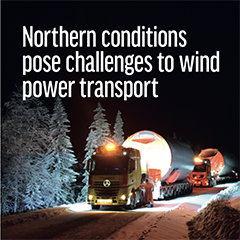Wind power transport requires extreme precision during the planning phase. The route choices and changes required by the roads can be anticipated during the planning phase, but the changing weather conditions in northern Europe can still surprise. The northern conditions require special transport expertise and an ability to act even in unforeseen circumstances. When large transport is involved, success depends on seamless cooperation and a multitude of details.
Changing weather may catch you unawares
Last summer, the Finnish Transport Company Ville Silvasti Ltd, a company that specialises in wind power transport, participated with its partner in the transport of the largest onshore wind farm in Europe in Roan, Norway. The 70 or so kilometres of road from Monstad harbour, up to the wind farm in the highlands and surrounded by the mountains were geographically challenging due to the winding roads and the differences in altitude.
‘In northern Europe, the weather may be dry, rainy, cold and slippery all during the same day. Despite the capricious weather, you have to be able to carry out special transport safely,’ says Project Director Kimmo Saukkonen from Silvasti.
The spring started exceptionally late, which delayed the start of the wind power transport in Roan. Even though there was spring weather and unfrozen ground in the harbour near the sea, the road leading to the mountains was soft due to the melting ground frost. Despite the tight schedule, the Silvasti personnel decided to delay the start of the transport to ensure safety.
Everything depends on the safety of transport equipment
In northern conditions, the wind power transport equipment is subjected to heavy strain. The strain is caused by factors such as freezing weather, which is hard on the engines and pneumatic systems. In addition to up-to-date and well-maintained transport equipment, it is also important to be able to carry out repairs immediately in case of a breakdown. Wind power transport often takes up the whole width of the road. This means that the rest of the traffic comes to a complete halt if a breakdown occurs.
At the Roan site, Silvasti had an agreement with local partners concerning sudden maintenance and repair needs. Silvasti’s own maintenance organisation, with its maintenance vehicles took care of the scheduled intervention on site.
Special transport is subject to many safety requirements monitored by the authorities. The objective is to ensure that special transport will inconvenience regular road users as little as possible.
‘During the project in Roan last summer, the wind power plant components were mainly transported to the wind farm at night. Thanks to the midnight sun, the lighting conditions during the northern summer are perfect for this. By contrast, the sun does not rise at all during the winter,’ Saukkonen laughs.




























